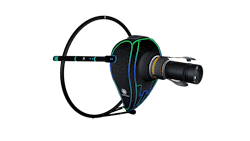Apu Saha believes learning should be ongoing through one’s life. He’s an engineer trained in electronics and telecommunication with a focus on semiconductor and silicon design from the Indian Institute of Technology in Chennai and co-guide of a master thesis program on configurable network processing at the Indian Institute of Science in Bengaluru. Saha is also an enterprise architect, has completed numerous courses in project management, and received a steady stream of on-the-job learning from experts at leading labs, such as Siemens, Alcatel, Ericsson, which set him up for success in building Motion Imager.
A wide-ranging background
Saha finished his degree in telecom engineering in 1994 and worked at Siemens as a team leader in their Enterprise Convergent Network until 2006. During that time, he focused on two primary projects: One was developing and deploying a closed communication network based on ATM technologies for India’s defense department; the other, a wireless network launch for General Packet Radio Services (GPRS), a packet-switched data service offering higher data speeds and simple wireless access to packet data networks via Global Systems for Mobile (GSM), a cellular standard for mobile phone communications.
This was an area that involved numerous products, protocols, and signaling systems. Saha’s roles included defining the overall architecture as well as each of the product parts—everything from creating the product to working with the product and engineering teams on technical specs. This broad-based knowledge helped grow his depth of understanding of the solutions and ways to problem-solve when issues arose—a stepping-stone for the next phase of his career.
During the next few years, Saha amassed a deeper understanding of networking infrastructure, complemented by a knowledge of industry needs and business dynamics, through a series of strategic, but varying, positions. After Siemens, he moved to Alcatel-Lucent in the role of project manager for Convergence Network – NGN, where he worked on their wireless network switching and intelligent network subsystems. Then, he joined ByCell Telecom as the director of service delivery and business development. He also held key positions in telecom markets at UNINOR and as principal designer of BT Innovate and Design in BT Global Services.
In 2013, Saha decided it was time to start his own company.
On his own
Saha believes starting a company stems from the confidence that experience and knowledge bring. He already had experience developing new product ideas and turning them into workable solutions. As someone who also enjoyed original research, he thought: “What if I could commercialize that research output? Would there be business value in it?”
Out of these ideas came BCAUSE, a hardware-software development research lab, where Saha focused on wireless sensor gateways to communicate with point-of-care elements.
While BCAUSE provided new opportunities, Saha’s love of learning drove him in a new direction. He was interested in a burgeoning field: deep tech, computation, and vision science, and he began independent research in these areas.
This next phase began, in part, because Saha loves taking on challenges. He seeks the thrill of solving an imminent need, but also wants to achieve value by connecting human- and earth-centric needs and identify a compromise between the two. So, he decided to act on the bedrock of his research findings to create a company to leverage new deep-tech learnings in support of more efficient industrial engineering processes.
Motion Imager
Saha founded Motion Imager in 2019 in India. The company was based on years of research into physics, optics, the mechanics of materials, and the nonlinear evolution of three-dimensional (3D) shapes and structures. His knowledge of the complex assembly-based manufacturing industry provided the necessary information to address inefficiencies.
When setting up Motion Imager, Saha questioned: “What if we could have visualization and acquisition of multiple interaction and dynamic scenarios to capture the phenomena of shape-structure shifting?” Motion Imager answered this question by using AI to enhance decision-making based on physics, and deep learning for industrial applications for intelligent parts’ pattern manufacture, assembly, and part design.
As Saha dove deeper into designing Motion Imager, he realized that to reach the audiences he was targeting, the company needed to be based in either the United States or Europe. He felt strongly that when building a photonics company, it needs to be close to supplies, skills, talent, manufacturing, and customers. His goal was to ensure access to raw materials and strong supply chain networks. He also wanted to dwell in a business ecosystem where a photonic company could thrive.
In 2021, Motion Imager moved to the Netherlands.
Imaging is everything
One of the key differentiators for Motion Imager is that structured multiphoton probe integrated 3D multiscale computational imaging is different than digital intensity-based imaging from digital cameras. This concept set the stage for Motion Imager to address 3D multi-nonrigid material and multipart assembly-based manufacturing process issues beyond classical linear Newtonian mechanics and visual perception-based mechanics of body and material dynamics modeling and parameterization.
A traditional digital intensity camera resolution is limited by the size of its lens and pixels. But a computational camera goes beyond the limits of the physics imposed by camera sensors and lenses: It can be manipulated through numerical calculations and algorithms, which greatly expands its capabilities.
A researcher can, for example, manipulate the photon strength and reflected ray direction on pixels or use diverse kinds of metalenses and configure them to capture the hidden details of the object’s dynamic-to-static behaviors under view through the reconstructed photographs. Motion Imager’s computational cameras capture mechanical shape and surface geometrical and mechanical metrologies, displacements, velocities, directions, and force fields acting on an object. This allows it to identify hidden physical features at multiscale level and estimate their future evolution, which lessens defects and rework in manufacturing and assembling.
This process makes sense for any industry that works in multistage, multipart assemblies of strategic importance—such as the automotive, aerospace, and textile industries. Most objects are made of multiple parts, but during assembly, variability and excess waste may occur. This is where computational cameras come into play: They can capture variabilities and inefficiencies in the manufacturing process.
When computational cameras are used on an auto assembly line, while a car is taking shape from the frame to the parts, they create a 3D history of the car. A car manufacturer in Germany may have factories located in Italy, with assembly lines and workbenches consisting of 55 to 85 stages. If a company equips each of these stages with a computational camera, it captures scene dynamics and calibrates each workpiece shift in geometrical dimension and mechanical properties—comparing how it’s being built to what the design specified. By capturing microdetails as the car moves through the process, it results in a digital inventory of all the details. With this information, the company can in real time correct material selection, geometry and shape, machine tooling specifications, and human or robot handling anomalies. Ultimately, this reduces company costs by lessening erroneous production, rework requirements, and rejections of incomplete or low-quality products.
Knowing the unknown
With computational cameras, the invisible becomes visible—helping companies see what’s happening in the process of making things and measuring them. These complex measurements can be captured by the camera, which captures curves, bends, lengths, heights, and weights, from the tiniest to the largest scale, in an autonomous environment—no human input is necessary to ensure the camera continues operating.
Today, Motion Imager cameras provide two types of outputs. One of them, play frame, is a static image with annotations about size or the scientific details about the image. The other is called play motion, a video version of play frame, which provides a 3D digital twin reconstructed of the mixed-scene dynamics, which can analyze the shape of motions of parts, manipulate the frame rate, and provide a deeper inspection of what’s occurred or is going to occur within the scene under the camera’s field of view.
Use cases
Use cases for these cameras abound in manufacturing, Saha says—particularly in the automotive industry. He sees the potential for Motion Imager cameras to be applied in part creation. When an auto company needs to cut out the piece where the hood will go, the machine that cuts it needs to align it properly. If the shape changes at some point during the assembly process, and it doesn’t align, the company has vehicle parts that won’t join together—and it’s wasted.
Beyond automotive needs, Motion Imager cameras have multiple use cases for the textile industry. In garment manufacturing, to make shirts fabric is cut into separate segments which can have complex geometries and cuts. When stitched, the sewing machines need to run at a particular speed, but there needs to be a gap between the side of a shirt and the area where the stitching goes in to ensure shear and seam strength for the garment’s structural stability. Buttonholes need to be straight and align with buttons. But what happens if there is one buttonhole slightly tilted or off position? The company may manufacture 50,000 pieces and not learn about the defect until it’s too late and it becomes an expensive problem.
Computational cameras help catch these types of errors by identifying the manufacturing defect as it happens to cut down on the potential for the product to progress to the next successive stage and, ultimately, will prevent waste or rework.
Looking ahead
Saha wants Motion Imager to serve as a de facto, unbiased tool for multiple industries. He believes the company’s technology will help bring about new, cost-efficient macroscale metamaterials. He’d like these metamaterials to be more Earth-centric or have natural recyclability.
Saha believes reducing waste by going to electricity or hydrogen only solves part of the problem and is not totally aligned with Earth-centric design. He says companies need to look at how to make the synthetic materials and what alternative Earth-extracted and processed materials work better for the product. At the same time, companies need to enhance their fully assembled products’ performance and efficiency.
Saha’s vision aligns with what he’s believed throughout his career: “If you put your mind to something and the impact is transformative and a value creator, it becomes your 'why' and drives you to make changes. With this mindset, you can do anything,” he says.
About the Author
Jose Pozo
Chief Technology Officer, Optica
Jose Pozo joined Optica in March 2022, and has spent more than 25 years working in photonics. He earned a PhD in quantum physics from the University of Bristol (U.K.), and an M.Sc. and B.Eng. in telecom engineering from UPNA, Spain / VUB (Belgium). Prior to joining the European Photonics Industry Consortium (EPIC) in 2015 as CTO, Jose was a Senior Photonics Technology Consultant with PNO Consultants, with some of the main accounts such as CERN, Thales, and TE Connectivity. He has worked at TNO, The Netherlands Organization for Applied Scientific Research, and as a postdoctoral researcher at the Eindhoven University of Technology in the Netherlands, where he contributed to the early development of EFFECT Photonics.

